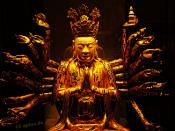In the Buddhist tradition, there is a notion of the "self"� in relations to one's position in the universe. Buddhism uses the concept of anatman and rebirth to describe this relationship. The anatman can be compared to the Hindu doctrine of the atman to best understand its qualities and what it represents.
In Hinduism, the self or atman is defined to be the soul or essence of one being. In this perspective, there is a notion of individualism in the soul and a distinct difference and separation between a person and the universe. The self in this sense also contains inseparable and distinctive qualities that are uniquely different. Each person contains a self that is individually unique and is regarded as a whole or one. In Buddhism however, the notion of the self in the individualistic sense is rejected. Buddhists believes that the self is actually composed of five components or aggregates called skandhas.
The human skandhas are body, feelings, perceptions, disposition, and consciousness. When the skandhas come together and interact, they appear to be in an individualistic and unique whole but this is an illusion. The aggregates only seem this way because when they collectively interact with each other and it produces a unique set of characteristics that resembles the Hindu version of the soul. Through experience and growth, the anatman is always changing so it is essentially a continuum or process.
In respect to rebirth, the Hindu notion believes in the transferring of the soul from one body to another. In this process, the soul remains the same but merely exchanges an outer shell. This is similar to a hermit crab changing its shell. Figuratively speaking, the crab is the soul and the shell is the body. The Buddhist view on rebirth on the other hand is...


